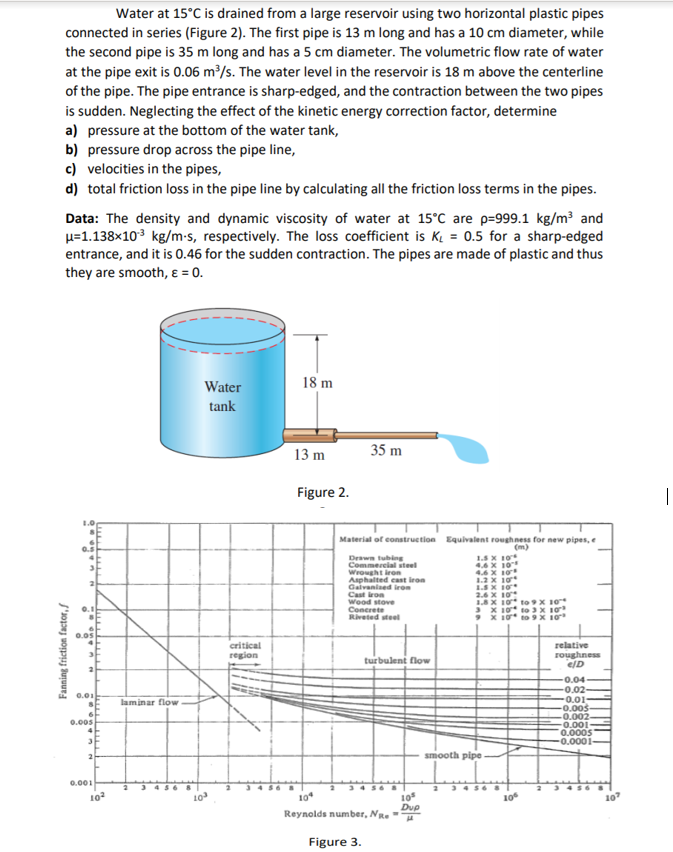Water at 15°C is drained from a large reservoir using two horizontal plastic pipes connected in series (Figure 2). The first pipe is 13 m long and has a 10 cm diameter, while the second pipe is 35 m long and has a 5 cm diameter. The volumetric flow rate of water at the pipe exit is 0.06 m³/s. The water level in the reservoir is 18 m above the centerline of the pipe. The pipe entrance is sharp-edged, and the contraction between the two pipes is sudden. Neglecting the effect of the kinetic energy correction factor, determine a) pressure at the bottom of the water tank, b) pressure drop across the pipe line, c) velocities in the pipes,
Water at 15°C is drained from a large reservoir using two horizontal plastic pipes connected in series (Figure 2). The first pipe is 13 m long and has a 10 cm diameter, while the second pipe is 35 m long and has a 5 cm diameter. The volumetric flow rate of water at the pipe exit is 0.06 m³/s. The water level in the reservoir is 18 m above the centerline of the pipe. The pipe entrance is sharp-edged, and the contraction between the two pipes is sudden. Neglecting the effect of the kinetic energy correction factor, determine a) pressure at the bottom of the water tank, b) pressure drop across the pipe line, c) velocities in the pipes,
Principles of Heat Transfer (Activate Learning with these NEW titles from Engineering!)
8th Edition
ISBN:9781305387102
Author:Kreith, Frank; Manglik, Raj M.
Publisher:Kreith, Frank; Manglik, Raj M.
Chapter7: Forced Convection Inside Tubes And Ducts
Section: Chapter Questions
Problem 7.27P
Related questions
Question

Transcribed Image Text:Water at 15°C is drained from a large reservoir using two horizontal plastic pipes
connected in series (Figure 2). The first pipe is 13 m long and has a 10 cm diameter, while
the second pipe is 35 m long and has a 5 cm diameter. The volumetric flow rate of water
at the pipe exit is 0.06 m³/s. The water level in the reservoir is 18 m above the centerline
of the pipe. The pipe entrance is sharp-edged, and the contraction between the two pipes
is sudden. Neglecting the effect of the kinetic energy correction factor, determine
a) pressure at the bottom of the water tank,
b) pressure drop across the pipe line,
c) velocities in the pipes,
d) total friction loss in the pipe line by calculating all the friction loss terms in the pipes.
Data: The density and dynamic viscosity of water at 15°C are p=999.1 kg/m³ and
u=1.138×103 kg/m-s, respectively. The loss coefficient is KĻ = 0.5 for a sharp-edged
entrance, and it is 0.46 for the sudden contraction. The pipes are made of plastic and thus
they are smooth, ɛ = 0.
Water
18 m
tank
13 m
35 m
Figure 2.
Material of construction Equivalent roughness for new pipes, e
0.5
(m)
Drawn tubing
Commercial steel
Wrought iron
Asphalted cast iron
Galvanised iron
Cast iron
Wood stove
Concrete
Riveted steel
44X 10
4.6 X
12x 10
2.6 x 10
1.8X 10 toX 10
0.1
0.0s
critical
region
relative
roughness
e/D
turbulent flow
-0.04
-0.02-
0.01
0.01
0.00s-
-0.002-
-0.001-
0.000s
-0.0001-
laminar flow
0.005
2
smooth pipe
0.001
10
10
Dup
10
102
107
Reynolds number, NR.
Figure 3.
Fanning friction factor,
Expert Solution
This question has been solved!
Explore an expertly crafted, step-by-step solution for a thorough understanding of key concepts.
This is a popular solution!
Trending now
This is a popular solution!
Step by step
Solved in 4 steps with 5 images

Knowledge Booster
Learn more about
Need a deep-dive on the concept behind this application? Look no further. Learn more about this topic, mechanical-engineering and related others by exploring similar questions and additional content below.Recommended textbooks for you

Principles of Heat Transfer (Activate Learning wi…
Mechanical Engineering
ISBN:
9781305387102
Author:
Kreith, Frank; Manglik, Raj M.
Publisher:
Cengage Learning

Principles of Heat Transfer (Activate Learning wi…
Mechanical Engineering
ISBN:
9781305387102
Author:
Kreith, Frank; Manglik, Raj M.
Publisher:
Cengage Learning